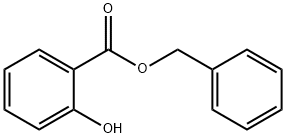Benzyl salicylate is a salicylic acid benzyl ester, a chemical compound most frequently used in cosmetics. It appears as an almost colorless liquid with a mild odor described as "very faint, sweetfloral, slightly balsamic" by those who can smell it, but many people either can't smell it at all or describe its smell as "musky". Trace impurities can have a significant influence on the odour.[1] It occurs naturally in a variety of plants and plant extracts and is widely used in blends of fragrance materials.
There is some evidence that people can become sensitized to this material and as a result there is a restriction standard concerning the use of this material in fragrances by the International Fragrance Association.
It is used as a solvent for crystalline synthetic musks and as a component and fixative in floral perfumes such as carnation, jasmine, lilac, and wallflower.
Benzyl Salicylate occurs in several essential oils, is a colorless, viscous liquid with a weak, sweet, slightly balsamic odor and a sweet, currant-like taste. It is soluble in ethanol, most non-volatile and volatile oils, slightly soluble in propylene glycol, insoluble in glycerin and practically insoluble in water.
It has been reported in small amounts in carnation oil (Dianthus caryophyllus L.) and in larger amounts in the
oil of Primula auricula. Also found in American cranberry, clove bud, peppermint oil and buckwheat.
benzyl salicylate is a fragrance found naturally occurring in carnations and in certain members of the primrose family. Although it can be derived for cosmetic use from natural essential oils, such as jasmine oil, neroli, and ylang-ylang, it can also be synthetically manufactured.
Benzyl Salicylate is an chemical compound commonly used in the cosmetic industry. Benzyl Salicylate is also found in essential oils from green tea and was shown to exhibit antioxidant and antimicrobia
l activity.
ChEBI: Benzyl salicylate is a benzoate ester and a member of phenols. It is functionally related to a salicylic acid.
By esterification of salicylic acid with benzyl alcohol.
Colorless liquid. Melting point near room temperature (18-20°C). As fixer in perfumery; in sunscreen preparations.
Benzyl salicylate may hydrolyze in aqueous acid or basic solutions. Benzyl salicylate can react with oxidizing materials.
Flash point data for Benzyl salicylate are not available, but Benzyl salicylate is probably combustible.
Flammability and Explosibility
Non flammable
Benzyl salicylate is used as fixer in perfumery and sunscreen
preparations. As a (weak) perfume sensitizer, it has
to be listed by name in cosmetic preparations in the EU.
Moderately toxic by ingestion. Seealso BENZYL ALCOHOL, SALICYLIC ACID, andESTERS. Combustible when exposed to heat or flame.When heated to decomposition it emits acrid smoke andirritating fumes. Incompatible with oxidizing materials.
Benzyl salicylate poses dangers to sensitive skin. Even in very small amounts, it may cause allergic reactions when applied to the skin. Benzyl salicylate can cause contact dermatitis (skin irritation) to people with sensitive skin types. It is also on the European Commission's list of 26 known allergens. Some of the other ingredients on the fragrance allergen list include linalool, coumarin, geraniol, and limonene.


